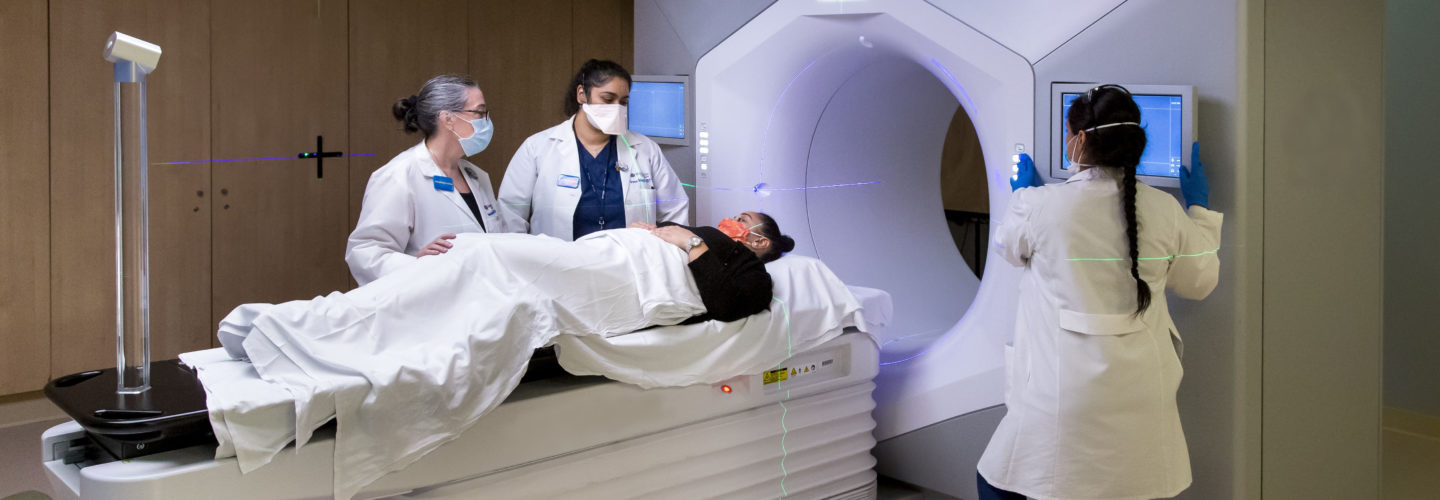Radiation therapy (also called “radiotherapy” and frequently abbreviated as “RT”) is a type of cancer treatment that uses high doses of ionizing radiation to kill cancer cells and shrink tumors. It generally is delivered by a machine called a linear accelerator with high energy X-rays, but protons, electrons, or other types of energy also can be used. It is estimated that 60% of all cancer patients will require radiation therapy at some point in their disease. The Maimonides Cancer Center’s Radiation Oncology Department employs a wide range of modern technologies to deliver the radiation treatment best suited to each individual patient’s needs.
Your radiation oncologist will work with the rest of the radiation therapy team to determine which radiotherapy techniques are right for you, based on tumor type, location, and size. Then they will develop your treatment plan, oversee treatment, and monitor your progress.
External beam radiation
External beam radiation uses a beam or beams of radiation to treat tumors. It involves a series of daily outpatient treatments that may last for a few days or for several weeks.
Types of external beam therapy
Three-dimensional conformal radiation therapy (3D-CRT)
3D-CRT uses sophisticated computers and CT or MRI scans to create detailed, 3D representations of the tumor and surrounding organs. This allows your radiation oncologist to shape radiation beams to the size and shape of your tumor and direct them precisely, sparing healthy tissue.
Intensity modulated radiation therapy (IMRT)
IMRT, a specialized form of 3D-CRT, further enhances radiation precision, often allowing the delivery of a higher and more effective dose, while limiting exposure of healthy tissues.
Electron beam therapy
Electron beam therapy is a less penetrating radiation that spares underlying tissues. It is best for patients whose cancers are near their skin’s surface, or for thick tumors in the skin.
Stereotactic radiotherapy
Stereotactic radiotherapy uses very small beams of radiation to destroy certain types of small tumors more precisely and quickly than other techniques. It also treats malformations in brain blood vessels and certain non-cancerous brain tumors.
Image-guided radiation therapy (IGRT)
IGRT uses imaging technologies during treatment to more accurately and safely deliver radiation to cancer cells.
Brachytherapy
Also called internal radiation, brachytherapy uses special applicators to implant a radioactive source inside or close to a tumor, allowing a large dose to target cancer cells with less exposure to healthy tissue. Brachytherapy may require anesthesia and brief hospitalization.
Isotope Therapy
Isotope therapy involves the administration of radioactive substances, usually in liquid form through an IV, to deliver radiation to cancer cells while delivering minimal doses to surrounding healthy cells. Maimonides radiation oncologists have extensive experience in the use of a variety of isotopes including their use for the treatment of metastatic prostate cancer.
Managing radiation side effects
Patients may experience side effects from radiation therapy which vary based on the type of tumor being treated, the course of RT, and an individual’s response to treatment. The most common side effect is fatigue, and other side effects are usually related to the area being treated. For example, irradiated skin may feel sunburnt, while radiation of the throat may cause soreness during swallowing. Your care team will discuss what side effects should be expected and how they should be managed.
Caring for yourself before, during, and after radiation therapy
When undergoing radiation therapy, it is important to:
- Eat a balanced, nutritious diet
- Get plenty of rest
- Seek emotional support
- Treat irradiated skin with extra care
Call (718) 765-2500 to make an appointment with an oncologist










